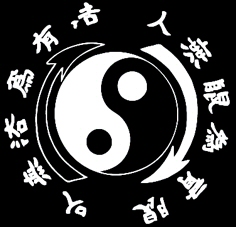Academy of Jeet Kune Do Fighting Technology
Athens
Greece
Jun Fan Jeet Kune Do Instructor
Vagelis Zorbas


Karambit
 The
first question that comes to mind is “What exactly is a Karambit?” The
Karambit can be defined as a small hand-held, curved fixed blade carried
for utility purposes and for personal safety purposes. Similar to the
relationship of the Pugio (Roman Dagger) to the Gladius (Sword of the
ancient Roman Legions), the Daga to the Espada (Spain), the Wakazashi to
the Katana (Japan) or the Dirk to the Basket-hilt (Scotland), the Main
Gauche to Le Sabre (France) and the Dagger to the Rapier (England) the
Karambit is considered a “backup” or “partner” in personal utility
as well as personal defense.
The
first question that comes to mind is “What exactly is a Karambit?” The
Karambit can be defined as a small hand-held, curved fixed blade carried
for utility purposes and for personal safety purposes. Similar to the
relationship of the Pugio (Roman Dagger) to the Gladius (Sword of the
ancient Roman Legions), the Daga to the Espada (Spain), the Wakazashi to
the Katana (Japan) or the Dirk to the Basket-hilt (Scotland), the Main
Gauche to Le Sabre (France) and the Dagger to the Rapier (England) the
Karambit is considered a “backup” or “partner” in personal utility
as well as personal defense.
The combination of the original design of the tiger’s claw combined with the hand weapons of the ancient characters of the Mahabharata and the Ramayana– the Kuku Macan, Kuku Bima or Kuku Hanuman has evolved into what is known in modern times as the Karambit. It is now recognized internationally as a traditional weapon of Pentjak Silat.
Traditionally, in ancient times, when a fighter unsheathed a battlefield-sized Karambit in the heat of hand-to-hand combat, the cutting edge was almost always smeared with some type of deadly poison which acted almost instantly upon entry into the bloodstream via laceration of the flesh.
 Even
the smallest cut was good enough to get the poison into the bloodstream.
Knowledge and usage of poisons derived from various species of poisonous
frogs, snakes, scorpions and spiders were considered an essential element
of a warrior’s arsenal of close quarter combative skills. These poisons
rapidly accelerated death and were most feared for their nearly
instantaneous killing power. This is another reason why Pentjak Silat
techniques and systems such as Sabetan and Rhikasan focus on the
immobilization of the hands at close quarters.
Even
the smallest cut was good enough to get the poison into the bloodstream.
Knowledge and usage of poisons derived from various species of poisonous
frogs, snakes, scorpions and spiders were considered an essential element
of a warrior’s arsenal of close quarter combative skills. These poisons
rapidly accelerated death and were most feared for their nearly
instantaneous killing power. This is another reason why Pentjak Silat
techniques and systems such as Sabetan and Rhikasan focus on the
immobilization of the hands at close quarters.
The Karambit, is therefore a utility tool and can also be used as an implement of personal protection and represents, skill, maturity, honor and wisdom. Those who are well versed in its usage as a measure of self-defense, have a greater advantage over those who do not. An ancient code of ethics reminds the warrior that his weapon should not be unsheathed without good reason or draw blood without honor.
The Karambit can be traced from Sumatra to Malaysia and Java. The Kerambit of Lombok, is traditionally a larger or “battlefield sized” Kerambit and is much larger than its more personal-sized Javanese cousin. There is also another variation of the Kerambit hailing from neighboring islands. There are also many different shapes and designs of the Kerambit such as Rajawali (bird head shape) and others which include protruding spurs used for tearing flesh in the heat of battle. The Kerambit is also referred to as the Kuku Bima (literally “the claw of Bima”). Pre-12th century influence as a result of Hindus settling in Indonesian archipelago, brought the Mahabharata (“great epic of the Bharata Dynasty”) and the Ramayana, (two major epics of India, valued for both high literary merit and religious inspiration), to Java. Contained within the Mahabharata is the Bagavadgita (“the Lord’s song”) which is the single most important religious text of Hinduism. Bima is a character from the Mahabrapta. Also known as Kuku Hanuman (literally “the claw of Hanuman” -a character from the Ramayana), the Kerambit, magical claw which protrudes from between the center of the hands of Bima and Hanuman, has become the weapon of the traditional arts of the Southeast Asian archipelago namely Pentjak Silat. Traditionally spelled either "KERAMBIT" or KARAMBIT" this amazing and ancient artifact can be used as a utility tool and as the last line of personal defense in a close quarter altercation.
In Sumatra, the
Minangkabau devised a myriad of hand enhancers and small knives with which
to fight. The most known weapon of this nature in the West is the Lawi
Ayam: the 'spur of the chicken'. Erroneously interpreted as a 'tiger
claw', the karambit (another name for the lawi ayam) is a human
cockfighting weapon. The root word karam is related to the base word for
'chicken' in Malay languages: ayam.
Indonesian Training Terminology
|
Anak Harimau |
Literally "son of
Tiger" usually referring to either a sub-system of a definite
posture (usually kneeling and/or lower to the ground). |
|
Buah |
Executed technique or
movement with training partner. |
|
Duduk |
Seated or sitting stance
or posture. |
|
Golang |
Circle or circular
movement usually in a wide circumference. |
|
Gunting |
Scissors-like motion.
This is the exact same word in Tagalog (national language of the
Philippines). Certain words In Tagalog such as Gunting, Bulan, Lima
and others are identical to those of Bahasay Indonesian. |
|
Harimau |
Tiger or tiger-style. |
|
Juru |
A singular technique or
movement without a partner. Similar to shadow boxing (Western
Boxing), Dtoi Lom (Thai Boxing) or Kata (Karate). |
|
Kakacangan |
A multiple of jurus (more
than one juru). |
|
Kahki |
Legs or having to do with
the legs. |
|
Kanan |
The right or to the
right-hand side. |
|
Kiri |
The left or to the
left-hand side. |
|
Kobok |
Takedown, throw or trip
using the arms. |
|
Kuda Kuda |
Horse stance or hose-like
posture. This can either be with legs wide, as in the example of
sitting on the back of a horse, or legs narrow as in the placement
of the horses hooves when walking. |
|
Ledok |
Takedown, throw or trip
using the legs. |
|
Picahan |
Literally "broken
apart" such as glass or shattered coffee cup. A term applied to
practical application of technique where a student (after achieving
a deep understanding of basic movements and standard technique) has
learned to "use the pieces" to create any solution on the
fly as needed in the heat of actual combat. |
|
Tangan |
Hands or having to do
with the hands. |
|
Totok |
Use of pressure points in
reference to placement of blade tip. |
